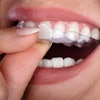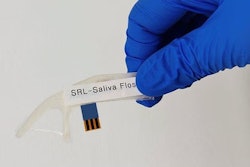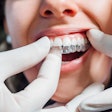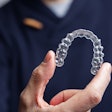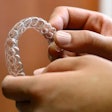Researchers have unveiled a smart wearable dental brace that captures never-before-seen in-mouth data that may lead to breakthrough treatments for conditions like bruxism and motor impairments.
MouthIO, which was developed by researchers at the Massachusetts Institute of Technology (MIT) Computer Science and Artificial Intelligence Laboratory (CSAIL) and Aarhus University in Denmark, is fitted with sensors and components that capture in-mouth interactions and data.
"With MouthIO, though, we've developed a new kind of device that's comfortable, safe, and almost invisible to others. Dentists and other doctors are eager about MouthIO for its potential to provide new health insights, tracking things like teeth grinding and potentially bacteria in your saliva," Michael Wessely, an Aarhus University associated professor and senior author of a paper discussing MouthIO's potential, said.
MouthIO resembles a clear retainer, but it has a panel on the side that holds batteries and sensors -- including those for temperature and acceleration -- and actuators that capture feedback. Additional small electronics can be placed on the outside of the panel, researchers said.
 A dental brace developed by researchers at MIT CSAIL and Aarhus University can be fabricated with sensors and feedback components to capture in-mouth interactions and data. Images courtesy of Sebastian Krog Knudsen and the researchers/MIT.
A dental brace developed by researchers at MIT CSAIL and Aarhus University can be fabricated with sensors and feedback components to capture in-mouth interactions and data. Images courtesy of Sebastian Krog Knudsen and the researchers/MIT.
MouthIO can be made using an intraoral scanner and a 3D printer using dental resin. There's a DIY method that uses a plaster impression, a scanning app such as Polycam, and 3D printing that costs approximately $15 and takes two hours to produce, according to the researchers.
Initial experiments that Wessely and colleagues did used an accelerometer sensor attached to the MouthIO that tracked jaw movements. It detected when users were grinding and biting and how often.
Down the road, Wessely and his colleagues hope that MouthIO can offer breakthroughs for individuals living with motor impairments, such as amyotrophic lateral sclerosis. Wessely and his team fitted MouthIO with small touchpads to detect tongue taps. Using tongue taps, it's believed that individuals with physical disabilities can use the MouthIO to communicate and perform many daily tasks hands-free.
"MouthIO is a great example how miniature electronics now allow us to integrate sensing into a broad range of everyday interactions,” study co-author, associate professor, and leader of the CSAIL Human-Computer Interaction Engineering Group, Stefanie Mueller, said. "I'm especially excited about the potential to help improve accessibility and track potential health issues among users."
